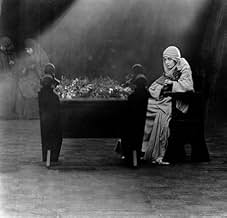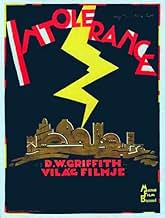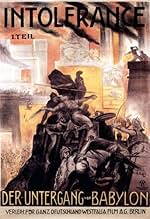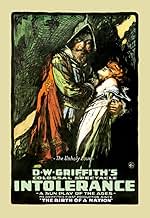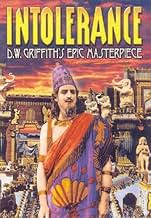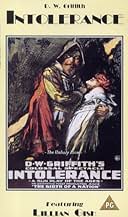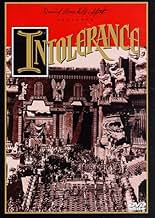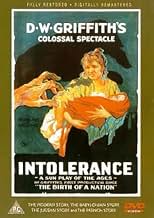VALUTAZIONE IMDb
7,7/10
17.514
LA TUA VALUTAZIONE
La storia di una povera giovane donna, separata dal pregiudizio dal marito e dal bambino, è intrecciata con i racconti di intolleranza nella storia umana.La storia di una povera giovane donna, separata dal pregiudizio dal marito e dal bambino, è intrecciata con i racconti di intolleranza nella storia umana.La storia di una povera giovane donna, separata dal pregiudizio dal marito e dal bambino, è intrecciata con i racconti di intolleranza nella storia umana.
- Regia
- Sceneggiatura
- Star
- Premi
- 2 vittorie totali
F.A. Turner
- The Dear One's Father
- (as Fred Turner)
Julia Mackley
- Uplifter
- (as Mrs. Arthur Mackley)
John P. McCarthy
- Prison Guard
- (as J.P. McCarthy)
Recensioni in evidenza
In 1915, D.W. Griffith's gave birth to modern cinema with "The Birth of a Nation", a giant leap that proved the remaining skeptics that the 20th century wouldn't do without the reel, that there was a time for Chaplin's gesticulations and a time for serious storytelling.
Of course, Chaplin's contribution is more valuable because he understood the universality of cinema more than any other filmmaker, let alone Griffith who made his film culminate with the glorification of the KKK. ¨People from all over the world would rather relate to the little tramp than any Griffith's character, but as I said in my "Birth of a Nation" review, without that seminal film, there wouldn't even be movies to contradict it.
And D.W. Griffith was actually the first to do so by making a humanistic anthology named "Intolerance: Love's Struggle Through the Ages", a three-hour epic relating four separate stories set at different historical times, but all converging toward the same hymn to intolerance, or denunciation of intolerance's effect through four major storylines: the fall of Babylon, the crucifixion of the Christ, the Bartholomew Day massacre and a contemporary tale with odd modern resonances. The four stories overlap throughout the film, punctuated with the same leitmotif of a mother "endless rocking the cradle", as to suggest the timeless and universal importance of the film.
The mother is played by an unrecognizable Lillian Gish but it's not exactly a film that invites you to admire acting, the project is so big, so ambitious on a simple intellectual level that it transcends every cinematic notion. It is really a unique case described as the only cinematic fugue (a word used for music), one of these films so dizzying in their grandeur that you want to focus on the achievements rather than the shortcomings, just like "Gone With the Wind" or more recently "Avatar". Each of the four stories would have been great and cinematically appealing in its own right, Griffith dares to tell the four of them using his trademark instinct for editing. Technically, it works.
And while I'm not surprised that he could pull such a stunt since he had already pushed the envelope in 1915, bmaking this "Intolerance" only one year after "The Birth of Nation" is baffling, especially since it was meant as an answer to the backlash he suffered from, it's obvious it wasn't pre-planned, so how he could make this in less than a year is extraordinary. I can't imagine how he got all these extras (three thousands), the recreations of ancient Babylon, of 16th century France, and still have time for a real story, but maybe that's revealing how eager he was to show that he wasn't the bigoted monster everyone accused him of, as if the scale of his sincerity had to be measured in terms of cinematic zeal. That the film flopped can even play as a sort of redemption in Griffith's professional arc.
But after the first hour, we kind of get the big picture and we understand that Griffith tells it like he means it. It works so well that the American Film Institute replaced the "Birth of a Nation" from the AFI Top 100 with "Intolerance" in the 10th anniversary update. But after watching the two of them, I believe they both belonged to the list as they're the two ideological sides of the same coin. But if one had to be kept, it would be the infamous rather than the famous, if only because the former is more 'enjoyable' in the sense that there's never a dull moment where you feel tempted to skip to another part. "Intolerance" had one titular key word: struggle, I struggled to get to the end, and even then, I had to watch it again because I couldn't stay focused. Indeed, what a challenging movie patience-wise!
This is a real orgy of set decorations that kind of loses its appeal near the second act, and while the first modern story is interesting because you can tell Griffith wanted to highlight the hypocrisy of our world's virtue posers, who try to make up for the very troubles they cause and use money for the most lamentable schemes, it might be too demanding to plug your mind to so many different stories. And when the climax starts with its collection of outbursts of violence, I felt grateful for finally rewarding my patience than enjoying the thrills themselves, especially since it doesn't hold up as well as the climactic sequence of "The Birth of a Nation". Or maybe we lost the attention span when it comes to silent movies, but there must be a reason the film flopped even at its time, maybe the abundance of notes and cardboards that makes the film look like a literary more than visual experience?
I guess "Intolerance" can be enjoyed sequence by sequence, by making as many halts as possible in that epic journey, but it's difficult to render a negative judgment for such a heavy loaded film. For my part, I'm glad I could finally watch and review all the movies from the American Film Institute's Top 100 and I appreciate its personal aspect in Griffith's career. Perhaps what the film does the best is to say more about the man than the director. His insistence on never giving names to his characters ("The Boy", "The Dear Guy"...) calling a mobster a "Musketeer" and all that vocabulary reveal his traditional and sentimental view of America, and maybe the rest of the world.
That's might be Griffith's more ironic trait, so modern on the field of technical film-making yet so old-fashioned in his vision, he's one hell of a storyteller and he handles the universal and historical approach of his film like a master, but when it comes to his personal vision, he struck me as the illustration of his own metaphor, like a good mother-figure endlessly rocking our cradle.
Of course, Chaplin's contribution is more valuable because he understood the universality of cinema more than any other filmmaker, let alone Griffith who made his film culminate with the glorification of the KKK. ¨People from all over the world would rather relate to the little tramp than any Griffith's character, but as I said in my "Birth of a Nation" review, without that seminal film, there wouldn't even be movies to contradict it.
And D.W. Griffith was actually the first to do so by making a humanistic anthology named "Intolerance: Love's Struggle Through the Ages", a three-hour epic relating four separate stories set at different historical times, but all converging toward the same hymn to intolerance, or denunciation of intolerance's effect through four major storylines: the fall of Babylon, the crucifixion of the Christ, the Bartholomew Day massacre and a contemporary tale with odd modern resonances. The four stories overlap throughout the film, punctuated with the same leitmotif of a mother "endless rocking the cradle", as to suggest the timeless and universal importance of the film.
The mother is played by an unrecognizable Lillian Gish but it's not exactly a film that invites you to admire acting, the project is so big, so ambitious on a simple intellectual level that it transcends every cinematic notion. It is really a unique case described as the only cinematic fugue (a word used for music), one of these films so dizzying in their grandeur that you want to focus on the achievements rather than the shortcomings, just like "Gone With the Wind" or more recently "Avatar". Each of the four stories would have been great and cinematically appealing in its own right, Griffith dares to tell the four of them using his trademark instinct for editing. Technically, it works.
And while I'm not surprised that he could pull such a stunt since he had already pushed the envelope in 1915, bmaking this "Intolerance" only one year after "The Birth of Nation" is baffling, especially since it was meant as an answer to the backlash he suffered from, it's obvious it wasn't pre-planned, so how he could make this in less than a year is extraordinary. I can't imagine how he got all these extras (three thousands), the recreations of ancient Babylon, of 16th century France, and still have time for a real story, but maybe that's revealing how eager he was to show that he wasn't the bigoted monster everyone accused him of, as if the scale of his sincerity had to be measured in terms of cinematic zeal. That the film flopped can even play as a sort of redemption in Griffith's professional arc.
But after the first hour, we kind of get the big picture and we understand that Griffith tells it like he means it. It works so well that the American Film Institute replaced the "Birth of a Nation" from the AFI Top 100 with "Intolerance" in the 10th anniversary update. But after watching the two of them, I believe they both belonged to the list as they're the two ideological sides of the same coin. But if one had to be kept, it would be the infamous rather than the famous, if only because the former is more 'enjoyable' in the sense that there's never a dull moment where you feel tempted to skip to another part. "Intolerance" had one titular key word: struggle, I struggled to get to the end, and even then, I had to watch it again because I couldn't stay focused. Indeed, what a challenging movie patience-wise!
This is a real orgy of set decorations that kind of loses its appeal near the second act, and while the first modern story is interesting because you can tell Griffith wanted to highlight the hypocrisy of our world's virtue posers, who try to make up for the very troubles they cause and use money for the most lamentable schemes, it might be too demanding to plug your mind to so many different stories. And when the climax starts with its collection of outbursts of violence, I felt grateful for finally rewarding my patience than enjoying the thrills themselves, especially since it doesn't hold up as well as the climactic sequence of "The Birth of a Nation". Or maybe we lost the attention span when it comes to silent movies, but there must be a reason the film flopped even at its time, maybe the abundance of notes and cardboards that makes the film look like a literary more than visual experience?
I guess "Intolerance" can be enjoyed sequence by sequence, by making as many halts as possible in that epic journey, but it's difficult to render a negative judgment for such a heavy loaded film. For my part, I'm glad I could finally watch and review all the movies from the American Film Institute's Top 100 and I appreciate its personal aspect in Griffith's career. Perhaps what the film does the best is to say more about the man than the director. His insistence on never giving names to his characters ("The Boy", "The Dear Guy"...) calling a mobster a "Musketeer" and all that vocabulary reveal his traditional and sentimental view of America, and maybe the rest of the world.
That's might be Griffith's more ironic trait, so modern on the field of technical film-making yet so old-fashioned in his vision, he's one hell of a storyteller and he handles the universal and historical approach of his film like a master, but when it comes to his personal vision, he struck me as the illustration of his own metaphor, like a good mother-figure endlessly rocking our cradle.
"Intolerance" is D.W. Griffith's apologia for "The Birth of a Nation" mostly in that it surpasses its predecessor's epic scale, thus replying to his critics. "The Birth of a Nation" was a racist film, and nothing in "Intolerance" proves otherwise, but I don't think that's the point, either. And, while Griffith calls his critics hypocrites, it's just as easy to call Griffith one for his racism. Yet, I have no disagreement that his films are art despite their messages. "Intolerance" contains much more agreeable views than "The Birth of a Nation", anyhow: Christian pacifism; support of labor; moderated progressivism; and condemnation of intolerance, hatred and inhumanity throughout the ages.
The narrative structure of "Intolerance" was revolutionary and particularly surprising for a filmmaker who had cemented in cinema a traditional and theatrical form of linear storytelling with his previous work. In "Home, Sweet Home" (1914), Griffith linked four separate stories with a single theme, but with each story told in full before proceeding to the next. With "Intolerance", he employed parallel editing, thus continually crosscutting between time, suspending plots and commenting on stories with other stories, and I think it's ingeniously congruent considering the stories are supposed to run parallel in their morals, or messages on the general theme of intolerance.
The four stories include a modern story, which features a fictional representation of the Ludlow massacre of strikers and a progressive era foundation of busybody reformers that indirectly causes the massacre and directly applies suffering on the central characters. It was originally intended as a complete film in itself and was later released as such under the title "The Mother and the Law". Then, there's the Babylonian story, which was also released by itself, as "The Fall of Babylon". It almost seems to be more likely to have been directed by Cecil B. DeMille than by D.W. Griffith, for all its sex and exotic set design against a historical setting. A contemporary of Griffith, however, DeMille had not yet figured out that formula and may well have been thinking of the Babylonian sequences in "Intolerance" when he did; one of his early pictures and first attempts at an epic, "Joan the Woman" (1917), does demonstrate Griffith's influence on him. Additionally, the sequence features the best performance in the film by ingénue Constance Talmadge as the "Mountain Girl". She, too, seems out of place in a Griffith production, with her sexuality, impropriety and independence. The lesser stories of Christ's life and his crucifixion and the events leading up to the St. Bartholomew's Day Massacre aren't especially interesting in themselves, as many have panned. Yet, I don't think that's essential, as they don't stand by themselves, but are part of a whole where they comment on and run parallel to each other and the other narratives.
The stories are connected by explanatory, as well as moralizing and poetical, intertitles and by glimpses of Lillian Gish endlessly rocking the cradle (taken from Walt Whitman). Reportedly, tinting also separated the stories upon initial release. Nearing the climax, however, these separations and transitions evaporate for an ever more merging and rapider plot. "Intolerance" is the apex of Griffith's innovations and developments in editing--the culmination of his achievements in "The Birth of a Nation" and his last-minute-rescue pictures and other Biograph shorts. Along the way, it was usually James and Rose Smith who aided him in the editing room. Doubtless, these achievements, especially in "Intolerance", greatly influenced the Soviet and European montage filmmakers, as well as subsequent filmmaking in general.
With the astounding success of "The Birth of a Nation", Griffith had the opportunity to make almost any film he wanted, and with "Intolerance" having cost nearly $400,000 to make, he did. (The some $100,000 budget for "The Birth of a Nation" had been unheard of in Hollywood.) The film's failure financially ruined Triangle Studios and considerably altered and limited Griffith's filmmaking career from thereon. As "The Birth of a Nation" demonstrated to Hollywood and the world how profitable and popular cinema could be, "Intolerance" told another important lesson on the risks and limitations involved.
Consuming much of the film's budget were Walter L. Hall's Babylon sets, and they are spectacular. They're also surprisingly imaginative and elaborate for D.W. Griffith, whose stagy, open-air sets in previous productions were generally unremarkable--besides those in "Judith of Bethulia" (1914), which pale in comparison. The influence of "Cabiria" (1914) is very evident, but where that film failed to equal the brilliance of its sets with the filming of them, "Intolerance" succeeds. The legendary crane shots are standouts.
Throughout the film, cinematographer "Billy" Bitzer masks the camera lens--more extensively than ever before--creating iris shots, a moving iris shot within a stationary shot and small-scale widescreen effects. Griffith and Bitzer are very much in control of the images, establishing us as spectators. The Babylonian scenes where characters look down at miniatures of the city, I think, also add to this emphasis. And, "Intolerance" is quite a spectacle, especially the Babylonian scenes. Overall, the cinematography, such as some extreme close-ups, is innovative and advanced. Additionally, Griffith and Bitzer once again proved themselves masters of filming battle scenes.
"Cabiria" and the other Italian epics were a great impetus for Griffith to have embarked on his own two epic masterpieces, but the Italian epics were merely super-theatrical, with "Cabiria" as its apex and somewhat of a bridge to Griffith making the epic a cinematic art and a cornerstone of the industry. Moreover, from his pioneering short films at Biograph, to the epics "The Birth of a Nation" and "Intolerance", and to a lesser extent, his work thereafter, nobody has had a greater influence on the course cinema would take than D.W. Griffith.
The narrative structure of "Intolerance" was revolutionary and particularly surprising for a filmmaker who had cemented in cinema a traditional and theatrical form of linear storytelling with his previous work. In "Home, Sweet Home" (1914), Griffith linked four separate stories with a single theme, but with each story told in full before proceeding to the next. With "Intolerance", he employed parallel editing, thus continually crosscutting between time, suspending plots and commenting on stories with other stories, and I think it's ingeniously congruent considering the stories are supposed to run parallel in their morals, or messages on the general theme of intolerance.
The four stories include a modern story, which features a fictional representation of the Ludlow massacre of strikers and a progressive era foundation of busybody reformers that indirectly causes the massacre and directly applies suffering on the central characters. It was originally intended as a complete film in itself and was later released as such under the title "The Mother and the Law". Then, there's the Babylonian story, which was also released by itself, as "The Fall of Babylon". It almost seems to be more likely to have been directed by Cecil B. DeMille than by D.W. Griffith, for all its sex and exotic set design against a historical setting. A contemporary of Griffith, however, DeMille had not yet figured out that formula and may well have been thinking of the Babylonian sequences in "Intolerance" when he did; one of his early pictures and first attempts at an epic, "Joan the Woman" (1917), does demonstrate Griffith's influence on him. Additionally, the sequence features the best performance in the film by ingénue Constance Talmadge as the "Mountain Girl". She, too, seems out of place in a Griffith production, with her sexuality, impropriety and independence. The lesser stories of Christ's life and his crucifixion and the events leading up to the St. Bartholomew's Day Massacre aren't especially interesting in themselves, as many have panned. Yet, I don't think that's essential, as they don't stand by themselves, but are part of a whole where they comment on and run parallel to each other and the other narratives.
The stories are connected by explanatory, as well as moralizing and poetical, intertitles and by glimpses of Lillian Gish endlessly rocking the cradle (taken from Walt Whitman). Reportedly, tinting also separated the stories upon initial release. Nearing the climax, however, these separations and transitions evaporate for an ever more merging and rapider plot. "Intolerance" is the apex of Griffith's innovations and developments in editing--the culmination of his achievements in "The Birth of a Nation" and his last-minute-rescue pictures and other Biograph shorts. Along the way, it was usually James and Rose Smith who aided him in the editing room. Doubtless, these achievements, especially in "Intolerance", greatly influenced the Soviet and European montage filmmakers, as well as subsequent filmmaking in general.
With the astounding success of "The Birth of a Nation", Griffith had the opportunity to make almost any film he wanted, and with "Intolerance" having cost nearly $400,000 to make, he did. (The some $100,000 budget for "The Birth of a Nation" had been unheard of in Hollywood.) The film's failure financially ruined Triangle Studios and considerably altered and limited Griffith's filmmaking career from thereon. As "The Birth of a Nation" demonstrated to Hollywood and the world how profitable and popular cinema could be, "Intolerance" told another important lesson on the risks and limitations involved.
Consuming much of the film's budget were Walter L. Hall's Babylon sets, and they are spectacular. They're also surprisingly imaginative and elaborate for D.W. Griffith, whose stagy, open-air sets in previous productions were generally unremarkable--besides those in "Judith of Bethulia" (1914), which pale in comparison. The influence of "Cabiria" (1914) is very evident, but where that film failed to equal the brilliance of its sets with the filming of them, "Intolerance" succeeds. The legendary crane shots are standouts.
Throughout the film, cinematographer "Billy" Bitzer masks the camera lens--more extensively than ever before--creating iris shots, a moving iris shot within a stationary shot and small-scale widescreen effects. Griffith and Bitzer are very much in control of the images, establishing us as spectators. The Babylonian scenes where characters look down at miniatures of the city, I think, also add to this emphasis. And, "Intolerance" is quite a spectacle, especially the Babylonian scenes. Overall, the cinematography, such as some extreme close-ups, is innovative and advanced. Additionally, Griffith and Bitzer once again proved themselves masters of filming battle scenes.
"Cabiria" and the other Italian epics were a great impetus for Griffith to have embarked on his own two epic masterpieces, but the Italian epics were merely super-theatrical, with "Cabiria" as its apex and somewhat of a bridge to Griffith making the epic a cinematic art and a cornerstone of the industry. Moreover, from his pioneering short films at Biograph, to the epics "The Birth of a Nation" and "Intolerance", and to a lesser extent, his work thereafter, nobody has had a greater influence on the course cinema would take than D.W. Griffith.
This silent film by director D.W. Griffith is well known to serious movie buffs and historians, but not to today's general public. I doubt that a lot of people these days would have the patience to sit through a film that contained three hours of silence. Nevertheless, the film's technical innovations inspired filmmakers in the 1920's and later, particularly in Russia and Japan. It also inspired filmmakers in the U.S., including Cecil B. DeMille and King Vidor. For this reason, and for other reasons, "Intolerance" is an important film.
The film's four interwoven stories, set in four different historical eras, are tied together thematically by the subject of "intolerance", a word which could be accurately interpreted today as "oppression", "injustice", "hate", "violence", and mankind's general inhumanity.
Griffith's narrative structure, though innovative, is uneven, because he gives more screen time to two of the four stories (the "modern" and the "Babylonian"). Equal time for three stories, thus deleting the fourth, might have worked better.
To me, the Babylonian story is the most interesting one because of its more complete coverage, and because of its elaborate costumes and spectacular sets. Even though there is no script, the viewer can easily discern the plot, which suggests that some of today's films might be just as effective, or more so, if screenwriters would downsize the dialogue.
What "Intolerance" offers most of all to contemporary viewers is a sense of perspective. Someone once said that despite the enormous advances in technology, society itself has advanced not at all. That may be true. In the eighty plus years since the film was released, technical advances in film-making have been obvious and impressive. But we are still plagued with the same old human demons of oppression, injustice, hate, violence, and ... intolerance.
The film's four interwoven stories, set in four different historical eras, are tied together thematically by the subject of "intolerance", a word which could be accurately interpreted today as "oppression", "injustice", "hate", "violence", and mankind's general inhumanity.
Griffith's narrative structure, though innovative, is uneven, because he gives more screen time to two of the four stories (the "modern" and the "Babylonian"). Equal time for three stories, thus deleting the fourth, might have worked better.
To me, the Babylonian story is the most interesting one because of its more complete coverage, and because of its elaborate costumes and spectacular sets. Even though there is no script, the viewer can easily discern the plot, which suggests that some of today's films might be just as effective, or more so, if screenwriters would downsize the dialogue.
What "Intolerance" offers most of all to contemporary viewers is a sense of perspective. Someone once said that despite the enormous advances in technology, society itself has advanced not at all. That may be true. In the eighty plus years since the film was released, technical advances in film-making have been obvious and impressive. But we are still plagued with the same old human demons of oppression, injustice, hate, violence, and ... intolerance.
How on Earth was D.W Griffith able to make this movie back in 1916? Back in the days when the audience were having a hard time focusing on two parallell stories, Griffith gave them four... This is a tremendous spectacle, way ahead of its time, and hardly dated at all. OK, the acting is a little bit over the edge (although Mae Marsh is a personal favourite of mine) and the subtitles are sometimes ridiculous, but the message that this movie brings is absolutely timeless. In fact, this is really the first movie with a vision, an idea. A major influence on Russian director Eisenstein, one has to wonder: Would there have been a Potemkin without this masterpiece? The Birth of a nation is in some ways superior to Intolerance, but for pure strength, innovation and boldness, Intolerance is unsurpassed and unsurpassable. The greatest movie of all times.
My primary interest in this was as a foundation of cinema; so an academic interest, but - having influenced so many things I am very keen on - not without some excitement at the prospect of discovery of this early common source.
So much of cinema flows out from this; a host of recognizable names tutored on set - Von Stroheim, Tod Browning, Woody Van Dyke, Victor Fleming, Elmer Clifton, Jack Conway, King Vidor - and even more once the film rippled across the world. In Moscow, it was the raw material film students were given to dismantle in Lev Kuleshov's fledgling film school, the first ever. And in France Abel Gance must have been awe-struck by the sheer size of the canvas, if his own films offer any clue.
So yes, a fast-paced, lavish blockbuster - it cost at the time an unprecedented $2m to make - with literally a cast of thousands animating history, the story of Hollywood excess begins here - in Italy it had started earlier, with their Roman spectacles. The filmmaker as god, who does not simply photograph reality but constructs entire worlds, permits our vision to travel in the places that we could earlier only imagine.
But the fundamental technique is still from the theatre; that means a grand stage - elevated from us, separate - with every now and then a different backdrop, actors who pantomime sweeping emotion, the eye usually fixed in a distance. Oh the camera moves, but it moves with the stage. And what a grand stage it is.
I suppose it must have been desirable at the time when cinema, and so the possibilities of seeing, made the world feel so new and perhaps so alive again, when so many of the trials and heroism of the world narrative were yet to be immortalized in this new way, that a film like this should try to encompass so much; the Crucifixion, medieval France, ancient Babylon, they're all urgently envisioned in the same space.
It is in more ways than one that Griffith wrote the history of cinema then; by pioneering what he did in terms of a film language, but also by creating a vast expanse - a daunting 3 hours of film - that fills the prehistoric void, in terms of cinema, with a cachet of images, that creates a history of images. Now with the Pharisees or at the Persian camp of Cyrus, the court of Catherine or the harems of Babylon, common streets old and new; now we could point back and see, in a small measure, a history of film gathered in one place. So, when Kuleshov had tasked his students to rework the film, the choice was wise. There is so much here in terms of images, and so fertile for remodeling, that essentially he was presenting them with the empty sheet to write music on - that music, a deeply modernist product of synthesis, we called montage.
What does this filmmaker - as god - see though, what kind of worldview does he spring into life, this is more interesting I believe.
The title summarizes well. So, a cruel - but institutionalized, thus state sanctioned - evil threatening to engulf and dissolve all that is kind, which is the individual life, and of course the warm sentimentality that eventually restores faith in the personal struggle. But nothing casts a shadow in this world, no depth or dimension beyond the plainly conceivable. So the people are straight-forward beings, either good or bad - our heroine is simply called The Dear One - or misguided at their most complex; or, when en masse, they are part of the decor, collectively writhing in some extravagant background.
By the end, a heavenly chorus of angels illuminate the sky above a battlefield. The immediate contrast, like so much in the film, disarms with how much painstaking vision must have gone into making something so splendorous yet so naive. We can pretend like we ought to make amends with the time it was made, just like we can't pretend to look away with indifference, but the point remains; far more complex works of art had been made before, far less didactic about their humanitarian values.
You should at least see the segment with the siege of Babylon though, and the final scenes cross-cutting across time and space as we rush to the climax; it's things like these that so much was founded on.
(And another image that I recommend to those of you who have been charting all this; it is an inexplicable, tight close-up of the girl who is almost brushing, breathing into the camera. It happens once, and suggests intimacy that is never again encountered in the film. It's as though the girl, and so this cinema, is yearning to cross over into a new kind of film where faces hold all the mysteries and performances visualize innermost soul. Jean Epstein would make those films, ushering us in a new perception)
So much of cinema flows out from this; a host of recognizable names tutored on set - Von Stroheim, Tod Browning, Woody Van Dyke, Victor Fleming, Elmer Clifton, Jack Conway, King Vidor - and even more once the film rippled across the world. In Moscow, it was the raw material film students were given to dismantle in Lev Kuleshov's fledgling film school, the first ever. And in France Abel Gance must have been awe-struck by the sheer size of the canvas, if his own films offer any clue.
So yes, a fast-paced, lavish blockbuster - it cost at the time an unprecedented $2m to make - with literally a cast of thousands animating history, the story of Hollywood excess begins here - in Italy it had started earlier, with their Roman spectacles. The filmmaker as god, who does not simply photograph reality but constructs entire worlds, permits our vision to travel in the places that we could earlier only imagine.
But the fundamental technique is still from the theatre; that means a grand stage - elevated from us, separate - with every now and then a different backdrop, actors who pantomime sweeping emotion, the eye usually fixed in a distance. Oh the camera moves, but it moves with the stage. And what a grand stage it is.
I suppose it must have been desirable at the time when cinema, and so the possibilities of seeing, made the world feel so new and perhaps so alive again, when so many of the trials and heroism of the world narrative were yet to be immortalized in this new way, that a film like this should try to encompass so much; the Crucifixion, medieval France, ancient Babylon, they're all urgently envisioned in the same space.
It is in more ways than one that Griffith wrote the history of cinema then; by pioneering what he did in terms of a film language, but also by creating a vast expanse - a daunting 3 hours of film - that fills the prehistoric void, in terms of cinema, with a cachet of images, that creates a history of images. Now with the Pharisees or at the Persian camp of Cyrus, the court of Catherine or the harems of Babylon, common streets old and new; now we could point back and see, in a small measure, a history of film gathered in one place. So, when Kuleshov had tasked his students to rework the film, the choice was wise. There is so much here in terms of images, and so fertile for remodeling, that essentially he was presenting them with the empty sheet to write music on - that music, a deeply modernist product of synthesis, we called montage.
What does this filmmaker - as god - see though, what kind of worldview does he spring into life, this is more interesting I believe.
The title summarizes well. So, a cruel - but institutionalized, thus state sanctioned - evil threatening to engulf and dissolve all that is kind, which is the individual life, and of course the warm sentimentality that eventually restores faith in the personal struggle. But nothing casts a shadow in this world, no depth or dimension beyond the plainly conceivable. So the people are straight-forward beings, either good or bad - our heroine is simply called The Dear One - or misguided at their most complex; or, when en masse, they are part of the decor, collectively writhing in some extravagant background.
By the end, a heavenly chorus of angels illuminate the sky above a battlefield. The immediate contrast, like so much in the film, disarms with how much painstaking vision must have gone into making something so splendorous yet so naive. We can pretend like we ought to make amends with the time it was made, just like we can't pretend to look away with indifference, but the point remains; far more complex works of art had been made before, far less didactic about their humanitarian values.
You should at least see the segment with the siege of Babylon though, and the final scenes cross-cutting across time and space as we rush to the climax; it's things like these that so much was founded on.
(And another image that I recommend to those of you who have been charting all this; it is an inexplicable, tight close-up of the girl who is almost brushing, breathing into the camera. It happens once, and suggests intimacy that is never again encountered in the film. It's as though the girl, and so this cinema, is yearning to cross over into a new kind of film where faces hold all the mysteries and performances visualize innermost soul. Jean Epstein would make those films, ushering us in a new perception)
Lo sapevi?
- QuizDuring filming of the battle sequences, many of the extras got so into their characters that they caused real injury to one another. At the end of one shooting day, a total of 60 injuries were treated at the production's hospital tent.
- BlooperOne of the early title cards in the Judean sequence refers to Jesus having been from "the carpenter shop in Bethlehem". Though he was born in Bethlehem, he worked with his father in a carpenter shop in Nazareth, which is why he was known as Jesus of Nazareth.
- Citazioni
Intertitle: When women cease to attract men, they often turn to reform as a second option.
- Curiosità sui creditiConstance Talmadge is credited as 'Georgia Pearce' for her performance as Marguerite de Valois in the French Story. She is credited under her own name in the role of The Mountain Girl in the Babylonian Story.
- Versioni alternativeThe movie was officially restored in 1989 by Kevin Brownlow and David Gill for Thames Television. It was transferred from the best available 35mm materials, color-tinted per D.W. Griffith's intent, and contains a digitally recorded orchestral score by Carl Davis. This 176-minute version was released on video worldwide, but has never been telecast in the U.S.
- ConnessioniEdited into The Fall of Babylon (1919)
I più visti
Accedi per valutare e creare un elenco di titoli salvati per ottenere consigli personalizzati
- How long is Intolerance?Powered by Alexa
Dettagli
- Data di uscita
- Paese di origine
- Lingua
- Celebre anche come
- Intolerance: A Sun-Play of the Ages
- Luoghi delle riprese
- Silver Lake, Los Angeles, California, Stati Uniti(Babylon set)
- Azienda produttrice
- Vedi altri crediti dell’azienda su IMDbPro
Botteghino
- Budget
- 385.907 USD (previsto)
- Tempo di esecuzione2 ore 43 minuti
- Mix di suoni
- Proporzioni
- 1.33 : 1
Contribuisci a questa pagina
Suggerisci una modifica o aggiungi i contenuti mancanti

Divario superiore
By what name was Intolerance (1916) officially released in Canada in French?
Rispondi

